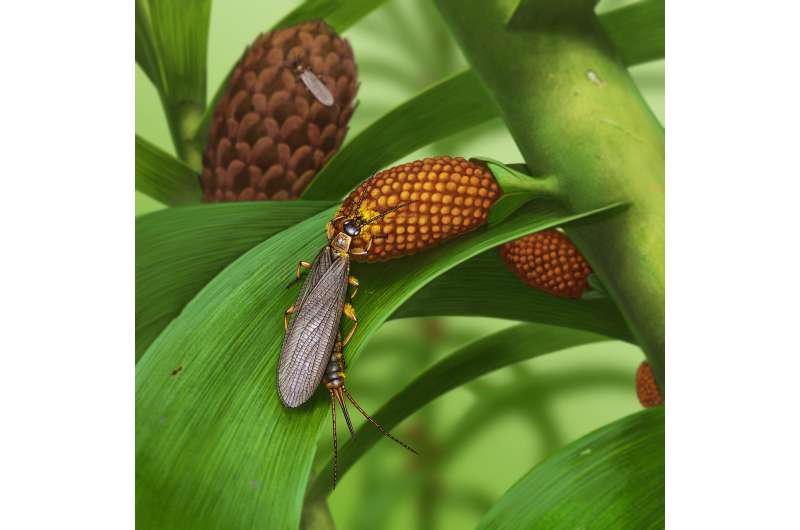Credit: Biology Letters (2023). DOI: 10.1098/rsbl.2022.0523
A trio of paleontologists, two with the Russian Academy of Sciences, the third with the University of Silesia in Katowice, has identified the oldest known pollen-carrying insect. The research by Alexander Khramov, Tatiana Foraponova and Piotr Węgierek has been published in Biology Letters.
Until this new find, the oldest known pollen-carrying insect had been dated to approximately 160 million years ago. These new specimens were ground-dwelling Tillyardembia, and lived approximately 280 million years ago, during the Permian period. They were originally found at a dig site near the town of Chekardain in Russia, in rocks along a riverbank. The researchers report that the earwig-like insects were approximately 1.5 centimeters long and had wings, though they were quite flimsy, suggesting the insects spent most of their time on the ground or crawling around on plants.
The researchers found the ground-dweller while combing through a large collection of ancient insect fossils archived at the Borissiak Paleontological Institute, in Moscow. Of the 425 fossilized creatures, the team found six of the same insect type—each with bits of pollen grains sticking to their thoraxes, legs and abdomens. They suggest more of the insects in the collection likely were pollen carriers, but the evidence had been washed away when the specimens were cleaned for study.
The team found only two types of pollen, which suggests the insects spent most of their time on just one or two trees or bushes. Both kinds were from a type of seed-producing plant that did not have flowers, called gymnosperms.
The team acknowledges that it is not possible to determine from the fossil specimens or the pollen attached to them whether the insects were actually part of the plants' pollination process—if they were not, then they were likely at least precursors.
The team plans to continue study of the specimens to find evidence of a pollen-trapping mechanism, which would show that pollen-tracking was intentional. They also plan to take a closer look at the pollen to see if it had developed structures that helped it cling to any pollinators that happened by.
More information: Alexander V. Khramov et al, The earliest pollen-loaded insects from the Lower Permian of Russia, Biology Letters (2023). DOI: 10.1098/rsbl.2022.0523
Journal information: Biology Letters
© 2023 Science X Network























